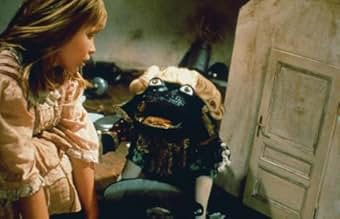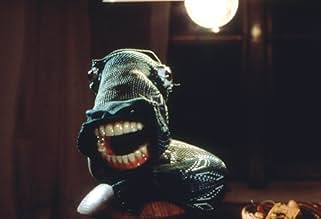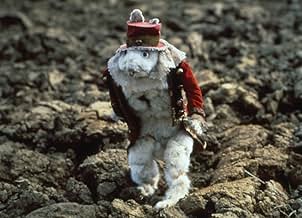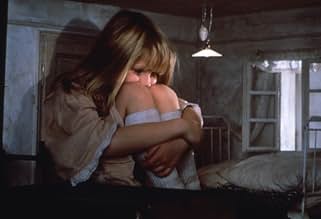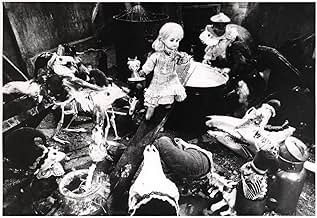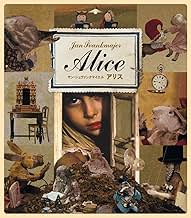VALUTAZIONE IMDb
7,4/10
14.752
LA TUA VALUTAZIONE
Aggiungi una trama nella tua linguaA surrealistic revision of Alice in Wonderland.A surrealistic revision of Alice in Wonderland.A surrealistic revision of Alice in Wonderland.
- Regia
- Sceneggiatura
- Star
- Premi
- 1 vittoria e 1 candidatura in totale
Camilla Power
- Alice
- (English version)
- (voce)
Recensioni in evidenza
We have all be introduced by either the written form or the theatrical form of the story of "Alice in Wonderland". Unfortunately, I feel that most of us have been introduced to this story through the film version instead of the written word. Sad as it may seem, we have all been sucked into either the Disney version, the Care Bear's version, or better yet even the recent made-for-TV version that was on ABC. So, with that being said, we all then know the story of Alice's journey through Wonderland. For all of you who have perhaps missed out on this fabled children's tale, let me recap for you quickly:
White Rabbit, Small and Big, Caterpillar, Tweetlede & Tweetledum, the Walrus, the pig baby, the Queen of Hearts, the Mad Hatter, "Off with their heads!!!", the Cheshire cat, and the Alice dream.
Although that may seem like a jumbled line of words and phrases, that actually accurately sums up the entire plot of the children's story. What surprises me is that over time the film versions of this story have not changed. They have continued to show this innocent child being swept up in this imaginary and beautiful "Neverland" where she finds herself being the center of attention. I am not sure if studios are afraid to topple the Disney version, or if there is no creativity running through the minds of writers to make a fresh new story of this old tale, but something needed to be done. It was a tired story, that needed a modern day face-lift. With this said, let me introduce you to the Czech version of this fairy tale. While I applaud it for taking a much darker twist to this story, I do denounce it's use of stop motion animation to create the impossible.
Lewis Carroll, the author of the story, really intended "Alice in Wonderland" to be a very scary and dark story for children, and until Disney put their hands on it...it was. What Czech director Jan Svankmajer has done brought back the darkness to Alice. Almost taken from a page out the directing book by David Lynch, it abruptly begins with Alice announcing that she is going to watch a movie...this movie to be exact. She then proceed to play in her room. The movie does follow the actual story of Alice, but it takes a nightmarish version of the favorite characters. For example, the White Rabbit constantly looses his stuffing, only to pull his watch out of his stomach to proclaim that "He is very late for a date". He refills himself by eating wood chips that immediately fall back out of him. At the Mad Hatter party, a wind-up March Hare sits during the entire scene and butters watches to make sure that the gears get oiled. The lady who was watching the baby who is actually a pig is portrayed in this film as a frog footman who battles flies with a very lifelike tongue. Even the smallest of characters are evil. There is a scene with a door mouse that crawls up Alice's head when she is sitting in a pool of her own tears, and proceeds to set up camp in her hair.
For children...I think not...original...I think YES! While it even ends the same as the other versions of "Alice", the feeling that it leaves in your mind and stomach afterwards will be remembered further more than the cutesy animated version.
I tried hard to like this movie. It was art, it was foreign, it was from my native country...but I just couldn't connect with the stop-motion animation.
I don't want to stray you the wrong way, if you enjoy this style of animation, then I really recommend this film to you. I guarantee that you will never think of "Alice in Wonderland" in the same way. The symbolism was very strong and very poignant. I enjoyed how the feeling of Wonderland actually being a part of the house. I loved how the director used household items to create this normally "pretty or cuddly" characters. I also enjoyed the darkness to this film. When I think about it, I don't think of "Alice in Wonderland" as a children's story. A young girl follows a rabbit through an uncharted area (not worried that she is not home) and creates havoc all throughout this peaceful town. When she is finally caught, her punishment handed down by the elected Queen is not fulfilled...instead she awakens only to discover that it was a nightmare. I was always curious why there were so many cute characters in a nightmare. I think Svankmajer saw the darkness in the story and brought it out in this version.
Overall, I enjoy seeing another side of a story that our society loves so much. I love seeing artists take a vision that we have all seen before and turn it into their own design. I think this was done with this film. I applaud my Czech friend for all of the work on this film, and I suggest tackling yet another children's classic soon!!
Grade: *** out of *****
White Rabbit, Small and Big, Caterpillar, Tweetlede & Tweetledum, the Walrus, the pig baby, the Queen of Hearts, the Mad Hatter, "Off with their heads!!!", the Cheshire cat, and the Alice dream.
Although that may seem like a jumbled line of words and phrases, that actually accurately sums up the entire plot of the children's story. What surprises me is that over time the film versions of this story have not changed. They have continued to show this innocent child being swept up in this imaginary and beautiful "Neverland" where she finds herself being the center of attention. I am not sure if studios are afraid to topple the Disney version, or if there is no creativity running through the minds of writers to make a fresh new story of this old tale, but something needed to be done. It was a tired story, that needed a modern day face-lift. With this said, let me introduce you to the Czech version of this fairy tale. While I applaud it for taking a much darker twist to this story, I do denounce it's use of stop motion animation to create the impossible.
Lewis Carroll, the author of the story, really intended "Alice in Wonderland" to be a very scary and dark story for children, and until Disney put their hands on it...it was. What Czech director Jan Svankmajer has done brought back the darkness to Alice. Almost taken from a page out the directing book by David Lynch, it abruptly begins with Alice announcing that she is going to watch a movie...this movie to be exact. She then proceed to play in her room. The movie does follow the actual story of Alice, but it takes a nightmarish version of the favorite characters. For example, the White Rabbit constantly looses his stuffing, only to pull his watch out of his stomach to proclaim that "He is very late for a date". He refills himself by eating wood chips that immediately fall back out of him. At the Mad Hatter party, a wind-up March Hare sits during the entire scene and butters watches to make sure that the gears get oiled. The lady who was watching the baby who is actually a pig is portrayed in this film as a frog footman who battles flies with a very lifelike tongue. Even the smallest of characters are evil. There is a scene with a door mouse that crawls up Alice's head when she is sitting in a pool of her own tears, and proceeds to set up camp in her hair.
For children...I think not...original...I think YES! While it even ends the same as the other versions of "Alice", the feeling that it leaves in your mind and stomach afterwards will be remembered further more than the cutesy animated version.
I tried hard to like this movie. It was art, it was foreign, it was from my native country...but I just couldn't connect with the stop-motion animation.
I don't want to stray you the wrong way, if you enjoy this style of animation, then I really recommend this film to you. I guarantee that you will never think of "Alice in Wonderland" in the same way. The symbolism was very strong and very poignant. I enjoyed how the feeling of Wonderland actually being a part of the house. I loved how the director used household items to create this normally "pretty or cuddly" characters. I also enjoyed the darkness to this film. When I think about it, I don't think of "Alice in Wonderland" as a children's story. A young girl follows a rabbit through an uncharted area (not worried that she is not home) and creates havoc all throughout this peaceful town. When she is finally caught, her punishment handed down by the elected Queen is not fulfilled...instead she awakens only to discover that it was a nightmare. I was always curious why there were so many cute characters in a nightmare. I think Svankmajer saw the darkness in the story and brought it out in this version.
Overall, I enjoy seeing another side of a story that our society loves so much. I love seeing artists take a vision that we have all seen before and turn it into their own design. I think this was done with this film. I applaud my Czech friend for all of the work on this film, and I suggest tackling yet another children's classic soon!!
Grade: *** out of *****
A mix of live action and stop-action, this arthouse flick is intriguing but bizarre. But if I was a little kid I'd be scared out of my wits by The White Rabbit with bulging glass eyeballs & long, hamster-like fangs. Socks become wood-eating worms, Alice starts eating marmalade full of tacks, a tiny mouse lands on her head, punctures it & starts a fire, the rabbit hole she falls down starts as a desk drawer that grabs her & draws her in. The Alice doll she becomes when she's shrunk is sweet but sad. I have to admit it's fascinating and 180 degrees from the saccharine sweetness of the Disney film. See it on video to experience something completely different, and probably more towards the way Lewis Carroll intended the story to be...
About five years ago, when I had just graduated from high school, a friend of mine who had been to college introduced me to the works of Jan Svankmajer. He had checked out a VHS copy of three short films, Darkness/Light/Darkness, Male Games, and The Death of Stalinism in Bohemia. All three of them were works of great genius, and I immediately stored Svankmajer's name in my vault. So it's sad that it took me all five of these years to see another one of his works. I had thought about buying his Faust back when DVDs were dirt-cheap (do you remember those happy days?), but had passed over it for something else. Now I finally found another one of his films, Alice, this one a feature, his adaptation of Lewis Carrol's Alice's Adventures of Wonderland. And, wow, this is one frightening little film, a mix of live-action (well, one little girl) and stop-motion animation of characters like the White Rabbit, the Mad Hatter, and the Queen of Hearts. Stop-motion animation has always looked creepy, and Sankmajer knows it. He also knows that dead animals are scary, and he incorporates their bones into his animation. It makes the whole film more visceral and surreal.
There are two parts of this film that deserve particular attention. 1) the soundtrack. There is no musical score, and the only music at all is the tiny piece that plays over the closing credits. No, by soundtrack I am referring to the sound effects, and they are absolutely amazing. 2) the setting.The original novel and the Disney film set the story in a bizarre forest. Sankmajer sets the story in a delapidated house, with rotting and filthy wooden beams everywhere, creaky doors, and old cabinets. The setting is what makes the film particularly creepy.
As for standout scenes, the caterpillar is pretty awesome. The very best scene, though, is definitely the tea party, with the Mad Hatter and March Hare. Svankmajer's conception of those two characters and of the tea party is truly inspired, and ranks among the best scenes in cinema, in my opinion.
So is it perfect? No. The idea to have Alice speak all the lines, and then show her lips speaking such words as: "The Mad Hatter said" every two minutes grows annoying quickly, and the film would perhaps have been a masterpiece had this flaw been avoided. It seems to be in there for adding time, and it's truly unfortunate. I also wish that Svankmajer would have hurried up the beginning of the film, so as to get to other great scenes in the novel. It takes a half hour before Alice gets into Wonderland, and that's the only time the film grows boring. Whatever. This is still a great film. 9/10.
There are two parts of this film that deserve particular attention. 1) the soundtrack. There is no musical score, and the only music at all is the tiny piece that plays over the closing credits. No, by soundtrack I am referring to the sound effects, and they are absolutely amazing. 2) the setting.The original novel and the Disney film set the story in a bizarre forest. Sankmajer sets the story in a delapidated house, with rotting and filthy wooden beams everywhere, creaky doors, and old cabinets. The setting is what makes the film particularly creepy.
As for standout scenes, the caterpillar is pretty awesome. The very best scene, though, is definitely the tea party, with the Mad Hatter and March Hare. Svankmajer's conception of those two characters and of the tea party is truly inspired, and ranks among the best scenes in cinema, in my opinion.
So is it perfect? No. The idea to have Alice speak all the lines, and then show her lips speaking such words as: "The Mad Hatter said" every two minutes grows annoying quickly, and the film would perhaps have been a masterpiece had this flaw been avoided. It seems to be in there for adding time, and it's truly unfortunate. I also wish that Svankmajer would have hurried up the beginning of the film, so as to get to other great scenes in the novel. It takes a half hour before Alice gets into Wonderland, and that's the only time the film grows boring. Whatever. This is still a great film. 9/10.
This movie may be labeled frustratingly plotless by some, and that's fair, but the imagery in this strange combination of stop-motion animation and live footage is so hauntingly rich and evocative that you get the feeling that someone has secretly filmed your own childhood dreams and translated them into Czech - perhaps for the viewing pleasure of the former commissars. The basic idea is that all of ALICE IN WONDERLAND is occurring in Alice's house, and a staggering variety of household items are animated into jerky sort of life, while all the character voices - Mad Hatter, Queen of Hearts, White Rabbit - are spoken by Alice. Alice's house, however, is a Czech house, and the items are old even by Soviet bloc standards. It's as if an antique rummage sale suddenly sprang to life to act out a monstrous little comedy for one girl. And the architecture is simultaneously comforting and frightening. Windows, for example, merely open onto other rooms, all lit by bare light bulbs. What keeps the thing tied to Lewis Carroll is the performance of the little girl playing Alice. She appears to be about six or seven, and despite the disturbing events going on around her, she never appears frightened, and always investigates events as they grow curiouser and curiouser with a determined pluck. This little girl is always in control. What this adaptation lacks in forward momentum or narrative drive it makes up for with a surreal poetry of the domestic space as dreamed by a child.
Animation legend Jan Svankmajer applies his distinctive style to Lewis Carroll's most famous creation, crafting one of the most original and unforgettable takes on Alice's adventures ever put to film. Having previously adapted Carroll in his 1971 short film, "Jabberwocky," Svankmajer returns to the author's work with this amazing feature-length film. Employing a magnificent blend of live action and stop-motion animation, he uses many of Carroll's ideas as jumping-off points. Many of the characters are reconstructed as nightmarish abstracts of the way they have usually been depicted in previous adaptions. The white rabbit is a stuffed real rabbit who keeps his watch tucked in a sawdust-leaking gap in his chest. The Dormouse has been reduced to a creepy crawling foxlike hide, and the Caterpillar is a sock with eyeballs and teeth that sews its eyes shut when it sleeps. Although familiar characters such as the Mock Turtle and the Cheshire Cat are left out, Svankmajer's film is incredibly faithful to the book's sense of fantasy and absurdity. The minimal dialogue and pronounced sound effects also add to the overall unsettling mood. The key to truly appreciating this version is to forget the common associated imagery from other adaptions, and treat this as its own entity. Just as a dream makes a totally different impression on you than a person you describe it to (regardless of how well you describe it), this film is one man's surreal interpretation of another man's surreal description. The skull-headed birds, walking dolls, and broken-down furniture of Svankmajer's world make this a pretty disturbing telling of Alice's journey, but a masterful, enthralling, and undeniably unique one as well.
Lo sapevi?
- QuizDirector Jan Svankmajer had been disappointed by other adaptations of Carroll's book, which interpret it as a fairy tale. His aim was instead to make the story play out like an amoral dream.
- BlooperAfter testing the wooden mushroom fragments, Alice puts the piece that shrinks things in her right pocket and the other that enlarges things in the left one. In the next scene she encounters a tiny house and takes out the right hand fragment to enlarge it.
- ConnessioniFeatured in Brows Held High: Alice (2011)
I più visti
Accedi per valutare e creare un elenco di titoli salvati per ottenere consigli personalizzati
- How long is Alice?Powered by Alexa
Dettagli
- Tempo di esecuzione1 ora 26 minuti
- Mix di suoni
- Proporzioni
- 1.37 : 1
Contribuisci a questa pagina
Suggerisci una modifica o aggiungi i contenuti mancanti

